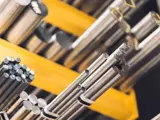Titanium vs. Advanced Aluminum Alloys: Choosing the Right Material for Critical Applications
When engineering teams face critical material selection decisions, two metals frequently emerge as frontrunners: titanium and advanced aluminium alloys. Both materials offer exceptional properties that make them indispensable across aerospace, automotive, and high-performance applications. However, understanding their distinct characteristics is essential for making informed decisions that can impact both performance and project economics.
At Dynamic Metals, we regularly advise engineers navigating these material choices, and the decision often comes down to specific application requirements rather than assuming one material is universally superior.
Understanding the Fundamentals
Titanium's Core Advantages
Titanium's reputation as a premium engineering material stems from its unique combination of properties. With a strength-to-weight ratio that surpasses most metals, titanium offers approximately 40% greater strength than aluminium whilst maintaining comparable density. This characteristic proves invaluable in applications where every gram matters, such as aircraft structural components or high-performance automotive parts.
The material's exceptional corrosion resistance makes it particularly suited to harsh environments. Unlike aluminium, which relies on protective oxide layers, titanium forms a stable, self-healing oxide film that provides superior protection against saltwater, acids, and extreme temperatures. This inherent resistance extends service life significantly, often justifying the higher initial investment through reduced maintenance costs.
Advanced Aluminium Alloys: The Evolution Continues
Modern aluminium alloys have evolved considerably from basic commercial grades. Advanced aerospace alloys such as 7075-T6 and 2024-T3 deliver strength levels approaching mild steel whilst maintaining aluminium's inherent weight advantages. These materials have become increasingly sophisticated, with precipitation-hardened alloys offering controlled mechanical properties through precise heat treatment processes.
The latest generation of aluminium-lithium alloys represents a particularly significant advancement, reducing density by up to 10% whilst improving stiffness by 15% compared to conventional aluminium alloys. These materials are finding increasing application in next-generation aircraft where every kilogram of weight reduction translates to measurable fuel savings over the aircraft's operational life.
Performance Comparison in Critical Applications
Strength and Structural Integrity
In terms of absolute strength, titanium alloys such as Ti-6Al-4V can achieve tensile strengths exceeding 1000 MPa, significantly higher than most aluminium alloys. However, when considering strength-to-weight ratios, the gap narrows considerably. Advanced aluminium alloys can deliver comparable performance in many structural applications, particularly where complex geometries allow for optimised design approaches.
The fatigue performance of these materials reveals interesting distinctions. Titanium exhibits superior fatigue resistance in high-cycle applications, making it preferred for rotating components and structures subject to repetitive loading. Aluminium alloys, whilst generally showing lower absolute fatigue limits, can be engineered with appropriate safety factors to provide adequate performance in most applications.
Temperature Performance
Operating temperature requirements often drive material selection decisively. Titanium maintains its mechanical properties up to approximately 400°C, whilst standard aluminium alloys typically show significant strength degradation above 150°C. This temperature stability makes titanium essential for applications near engine components, exhaust systems, or other high-temperature environments.
However, for applications operating within normal temperature ranges, aluminium's thermal conductivity advantage (approximately four times greater than titanium) can be beneficial for heat dissipation applications.
Economic Considerations and Processing
The cost differential between these materials extends beyond raw material prices. Titanium's processing requirements typically involve more sophisticated manufacturing techniques, specialised tooling, and longer machining times. These factors can result in finished component costs several times higher than equivalent aluminium parts.
Aluminium's manufacturing advantages include excellent machinability, established welding techniques, and widespread supplier availability. The material's formability allows for complex shapes through conventional manufacturing processes, reducing production complexity and associated costs.
Application-Specific Recommendations
Choose Titanium When:
- Operating temperatures exceed 200°C regularly
- Corrosive environments threaten long-term integrity
- Maximum strength-to-weight ratio is crucial
- Service life requirements exceed 20 years
- Fatigue loading is severe and repetitive
Choose Advanced Aluminium Alloys When:
- Cost efficiency is paramount
- Complex geometries require extensive forming
- Heat dissipation is beneficial
- Operating temperatures remain below 150°C
- Shorter replacement cycles are acceptable
Making the Decision: A Practical Framework
Successful material selection requires evaluating the complete application context rather than focusing solely on individual properties. Consider the following systematic approach:
Begin by defining non-negotiable requirements such as operating temperature, environmental exposure, and regulatory compliance. These factors often eliminate certain options immediately.
Next, evaluate the loading conditions throughout the component's service life. While titanium offers superior fatigue resistance, proper design with aluminium alloys can achieve adequate performance in many applications.
Finally, conduct a total cost analysis including material, processing, assembly, and lifecycle costs. Titanium's higher initial cost may be justified by extended service life and reduced maintenance requirements, but this must be validated against specific application requirements.
The Future Landscape
Both material families continue evolving through advanced processing techniques and alloy development. Additive manufacturing is opening new possibilities for titanium applications by reducing traditional processing constraints, whilst advanced aluminium alloys incorporate novel strengthening mechanisms and improved temperature resistance.
At Dynamic Metals, we maintain extensive inventories of both titanium and aluminium alloys in various grades and forms, enabling rapid prototyping and production support. Our technical team can provide specific guidance based on your application requirements, helping you navigate the complex trade-offs involved in critical material selection.
The choice between titanium and advanced aluminium alloys rarely has a definitively correct answer. Instead, success lies in understanding how each material's properties align with your specific requirements, constraints, and objectives. By taking a systematic approach to material selection, engineers can confidently specify materials that deliver optimal performance whilst meeting project constraints.
Whether your application demands titanium's exceptional properties or benefits from aluminium's practical advantages, the key lies in thorough analysis of requirements rather than assumptions about material superiority. Both materials have earned their place in critical applications through proven performance—the decision comes down to which properties matter most for your specific challenge.
Need more information? Get in touch

